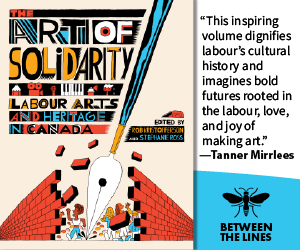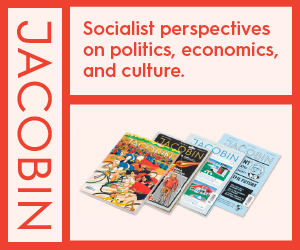Morbid symptoms: Alberta’s ‘Yellow Vest’ movement
While the protests in France have exhibited a left progressive bent, Alberta’s sound a rather familiar note of right-wing anger

Photo by Brendan Collinge/Flickr
Parroting—or perhaps parodying—the Yellow Vest movement in France, hundreds of similarly dressed protesters began taking to Alberta’s streets in the weeks leading up to Christmas 2018. On the surface, some of their grievances appear to mirror those of the French gilets jaunes—most especially, French President Macron’s increase of carbon taxes (particularly on diesel and gasoline). Macron’s taxes have their counterparts in those introduced by Alberta’s NDP government of Rachel Notley in early 2016 and a similar impending introduction of taxes by the federal Liberal government of Justin Trudeau.
But, as several writers have pointed out, there are important differences between these two participating groups. While the protests in France spontaneously drew tens of thousands into the street, and from across a wide swath of French society, the protests in Alberta were more organized and drew smaller crowds, primarily from the oil and gas sector. While France’s protesters expressed anger at their country’s very high taxes on the working class and growing inequality fueled by Macron’s generous treatment of the über rich, Alberta’s protesters—citizens of the lowest tax regime in Canada by far—cannot make such broad claims to economic injustice. Also while the protests in France have exhibited a left progressive bent, Alberta’s sound a rather familiar note of right-wing anger.
These differences aside, Alberta’s protests have gained steam. They began as placard-waving, street protests, but gained traction on December 19 when some Yellow Vests joined a convoy of 1,200 trucks. These vehicles driven by oil patch workers and their supporters had assembled in the town of Nisku, just south of Edmonton. Blocking traffic as it went, the convoy drove slowly to the capital and made known its demand that oil pipelines be built to “free” the resource from its land-locked status.
Three days later, the spectacle gave birth to similar pro-pipeline protests in other Alberta towns and cities, including Calgary, Brooks, Edson, Grande Prairie, and Medicine Hat. Hopping the provincial border, a trucker protest also took place in Estevan, Saskatchewan that same day.
While pipeline opposition is the immediate cause of the current fear and loathing, the narrative is a familiar one to political observers. Every time Alberta’s oil-based economy experiences a downturn, angst and anger rise, resulting in the search for enemies—so the argument goes—bent on keeping Albertans in perpetual servitude. While the provincial NDP government is blamed for being inept in handling the economy—and for simply being the NDP—much of the anger is focused upon the federal Liberals and Justin Trudeau, Quebec, and environmentalists. To this list some of the protesters have added the Supreme Court and the United Nations – the latter due to Canada’s recent decision to sign an accord on immigration.
The arguments advanced by protesters are rarely coherent, and often contradictory. The demonstrations have also attracted some unsavory elements, including anti-immigrant members of far-right hate groups, such as the Soldiers of Odin. But the protests have also received support from some highprofile, right-wing media pundits, politicians, and academics, among them Danielle Smith, a talk-show host and former Wildrose Party leader; Ted Morton, a former member of the now-defunct Progressive Conservative Party and prominent University of Calgary political scientist; Derek Fildebrandt, a former member of both the Wildrose and United Conservative parties, and current leader of his own breakaway “party of one,” the Freedom Conservative Party; and Jack Mintz, an economist with the conservative University of Calgary School of Public Policy. These endorsements have led to renewed talk of Alberta building a “firewall” against the rest of Canada. Separatist fantasies have returned on talk shows and in newspaper columns. But such utterances only function to deflect from serious discussion about how the province has arrived at its current economic cul-de-sac.
The years of magical thinking
Alberta’s economy is not simply resource based; it is, in fact, highly dependent upon one single resource—oil, a staple whose price is set on the world market. Under any circumstance, this would make the province’s finances prone to enormous volatility.
Peter Lougheed understood this when he became Alberta’s premier in 1971. He established the province’s Heritage Savings Trust Fund where a portion of royalties could be deposited for future generations. He also raised the royalty rate paid by oil companies to 35 percent and established the province’s nascent value-added industries, to break with Alberta being simply a producer of raw materials.
In the aftermath of a downturn in the 1980s, however, most of these efforts faltered; these safeguards disappeared entirely under the Ralph Klein administration in the 1990s. The Heritage Fund was starved: first, by a severe cut in royalty rates, to less than 10 percent, in an effort to attract foreign investment; and second, by the constant siphoning off of the proceeds that remained in order to keep taxes low, all in the name of a chimerical “Alberta Advantage.” (Today, the Pension Fund of Norway—modeled after Alberta’s fund—has over US$1 trillion in assets, about US$200,000 per Norwegian citizen. The Alberta Heritage Savings Trust Fund has total assets of less than CAN$18 billion, or a little more than CAN$4,000 per man, woman, and child in the province.)
Meanwhile, Alberta’s sources of conventional oil have all but dried up, so that the province had become more dependent upon the tar sands oil. Extracting oil from the sands has always been an expensive proposition, and remains comparatively so. The now famous “cost differential” is not a new thing, but Alberta could have itself refined the bitumen, creating added value, as Lougheed had wanted. But the Klein government made no demands of the oil companies to increase industrial capacity and the companies were more than happy to send the raw product to their already existing refineries on the American Gulf Coast. Alberta government finances increasingly relied on the mass production and sale of unprocessed oil: quantity over quality. In the early 2000s, the decision seemed to some a wise one, as the province regularly sported budget surpluses in the several billions. The majority of Albertans believed that the good times were going to stay.
But a series of social and technological developments shattered this cozy illusion. First, the world market was suddenly flooded with cheap oil. When the price of oil began slipping in early 2015, Alberta’s coffers took a massive hit, in the range of CAN$8-10 billion per year. Second, growing concerns over global warming have resulted in a sharp and irreversible turning away from carbon-based energy sources. Automobiles’ greater efficiencies are cutting into carbon usage, while sales of electric cars further threaten the utility of oil and gas vehicles. Third, in the midst of the downturn, Alberta’s oil companies shut down some operations and laid off workers, but they have also sought ways of reducing their costs. One of these ways is the introduction of self-driving vehicles in the industry. In early 2018, Suncor announced that it was building a fleet of over 150 driverless trucks to haul ore from its pits. The 400-tonne capacity Komatsu trucks will replace at least 400 jobs. But this is only the start. Long-haul trucking, a major industry throughout Canada, may be on the chopping block; hence, the actions of the Yellow Vest truckers.
People often resort to magic in moments of crisis; the demand of Alberta’s protesters for pipelines is one such magical solution. Pipelines will not save Alberta’s economy in the long term, and will only provide a few jobs in the short term. For many workers in the oil patch, however, pipelines appear to be the only game in town.
The Left’s necessary task
It is easy for left activists to write off protesting oil field workers as right-wing troglodytes, even fascists; recalcitrant lumpenproles of the big oil companies. A harder, but more useful task is to see beyond the rhetoric to the real human concerns of the Yellow Vest protesters for their livelihood, their homes, and their families. Rick Salutin’s description of France’s gilets jaunes as “an incoherent bunching of desperate, angry, normal people” can be equally applied to their Albertan doppelgängers. Canada’s Left must avoid the failed strategy of the Liberal Left in the U.S. who wrote off large sections of the American electorate in 2016 with unsympathetic and elitist dismissals—remember Hillary Clinton’s “basket of deplorables” comment?—that served only to harden Donald Trump’s electoral base. Of course, the Left must be vigilant of protesters being either used by corporations to push their interests, or being infiltrated by neo-fascist sympathizers. But the Left must not abandon its task in winning the hearts and minds of those legitimately left behind.
Alberta is in the midst of a brutal economic and social transition. The money that could have eased the pain is gone. Workers may not immediately understand the nature of the problem, how things got to where they are, or the way out. Lecturing and hectoring will get the Left nowhere; it is likely in fact to be counterproductive. Alberta’s and Canada’s Left must articulate in concrete terms the path to a practical alternative post-carbon future, one that offers empathy combined with real hope. Gramsci famously wrote of the kind of crisis Alberta is experiencing right now that “the old is dying and the new cannot be born; in this interregnum a great variety of morbid symptoms appear.” Alberta’s Yellow Vest movement is just such a symptom. The Left’s task is to ensure the Alberta that emerges does not revert to the failed lessons of the past.
Trevor Harrison is a Professor of Sociology at the University of Lethbridge and director of Parkland Institute, an Albertawide research organization. He is best known for his studies in political sociology, political economy, and public policy. He is the author, co-author, or co-editor of nine books, numerous journal articles and book chapters, and a frequent contributor to various media, including radio and television.
This article appeared in the Winter 2019 issue of Canadian Dimension (Injustice at Unist’ot’en).










